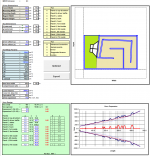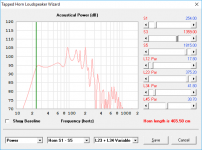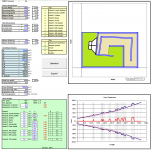I see the 3l and CSA but the flat board opposite the driver indicates the layout in the throat does not follow the expansion shown.
I'm not seeing that "flat board" that you're talking about in the online drawings that I'm seeing of the "Micro wrecker".
Ok, here's the "optimized" Microwrecker fold, using S3 near the first fold in the TH. The resulting Hornresp parameters are similar, but as close as I would like, to lilMike's sim, suggesting that the Microwrecker actually has S3 a bit further into the horn. I'll have a look at that tomorrow, but the resulting sim suggests that this is a ~24 Hz TH.
Note: the sim doesn't use "Lossy Le" or sem-inductance parameters, and the response of this TH is likely to be significantly impacted by the driver's high Le/Re ratio.
Note: the sim doesn't use "Lossy Le" or sem-inductance parameters, and the response of this TH is likely to be significantly impacted by the driver's high Le/Re ratio.
Attachments
The 15TBX100 and 15SW115 are both excellent choices for the MicroWrecker.
Would these drivers fare well in a LilWrecker as well?
How would you compare the MicroWrecker against Danley's TH-50, if you know the latter - pro's/con's with each design?
Cool, I can see how the three segments can be located in the TH (see attached diagram). This actually makes things a bit easier, as I might be able to adjust the optimization routine to approximate a full parabolic, conical or exponential expansion through the TH.
Out of curiousity, just let me know the external dimensions and the thickness of the panels that you used for the build. I'm curious to see if the optimization routine comes up with and how it compares to what you designed.
Wow - missed a bunch - sorry.
That first drawing is how I modeled it. I built the test mule with 3/4" nominal plywood (about 0.722 inches), external dimensions were 48" tall, 30.25" deep and 24" wide. Not my best cabinetry, but it did come together pretty quickly.
The CVX I used has an Le/Re of just over 1, so it is not that terrible as far as inductance goes. None of my modeling included any compensation for inductance, I used the actual Thiele Small parameters I measured as inputs. I got decent agreement with the model when I measured it after I put it together, but have never done a detailed measurement session on this cabinet.
Would these drivers fare well in a LilWrecker as well?
How would you compare the MicroWrecker against Danley's TH-50, if you know the latter - pro's/con's with each design?
Neither of the B&Cs offers enough stroke to work well in a lower tuned cabinet.
As far as listening impressions? I have heard TH-50s and I've listened to the Microwrecker for a couple years. The MicroWrecker was my effort to make something that can get close to what a TH-50 does. My build is driver-limited in comparison, the CVX is a pea-shooter compared to the TH-50 driver. Still, it does alright up until the driver's limits are reached.
They're both subs. Most of a subs perception in the room is related to the room, not the sub. Since they were in different rooms and settings with differing degrees of setup, I really can't compare.
Pros and cons? Come on...this is diyAudio. One costs more than my car did and was designed by a pro. It has gone through extensive R&D and testing done by professionals. The other was drawn up by a self-taught hobbyist, was built and tested by that same hobbyist, and has plans that are freely distributed on the Internet. That one must be awesome, right??
In all seriousness? I feel that the MicroWrecker is a reasonably good design, and with a decent driver it does a pretty good job, or I would not have shared the plans.
This is the latest version of my workbook model. Agreement between this and the published Hornresp sim is pretty close. It looks like you took the S3 point a bit further into the horn, but if I do that I think the optimization routine wouldn't be able to come up with a "perfect" solution and the internal panel across from the driver, which also forms part of the third bend in the horn (counting from S1) reflects the first expansion, not the second. In any case the impact on the frequency response of shifting S3 that extra bit is likely to be minimal. The driver's semi-inductance is likely to have a larger impact.
I've got a bit more work to do on the workbook, but one of the advantages of getting it mapped out in an optimization workbook is that it's now easy to try resizing it to see what difference it makes. For example, I was able to downsize the horn a bit to get a 30 Hz tune and smoother passband, particularly with minor stuffing added to the first half of the horn (according to the sim).
Anyway, once I finish getting the workbook to something usable, I'll add it to my site and post about it in the thread I have for these workbooks. It is an interesting fold that offers some advantages over the "SS15/TH115" fold.
I've got a bit more work to do on the workbook, but one of the advantages of getting it mapped out in an optimization workbook is that it's now easy to try resizing it to see what difference it makes. For example, I was able to downsize the horn a bit to get a 30 Hz tune and smoother passband, particularly with minor stuffing added to the first half of the horn (according to the sim).
Anyway, once I finish getting the workbook to something usable, I'll add it to my site and post about it in the thread I have for these workbooks. It is an interesting fold that offers some advantages over the "SS15/TH115" fold.
Attachments
Neither of the B&Cs offers enough stroke to work well in a lower tuned cabinet.
As far as listening impressions? I have heard TH-50s and I've listened to the Microwrecker for a couple years. The MicroWrecker was my effort to make something that can get close to what a TH-50 does. My build is driver-limited in comparison, the CVX is a pea-shooter compared to the TH-50 driver. Still, it does alright up until the driver's limits are reached.
They're both subs. Most of a subs perception in the room is related to the room, not the sub. Since they were in different rooms and settings with differing degrees of setup, I really can't compare.
Pros and cons? Come on...this is diyAudio. One costs more than my car did and was designed by a pro. It has gone through extensive R&D and testing done by professionals. The other was drawn up by a self-taught hobbyist, was built and tested by that same hobbyist, and has plans that are freely distributed on the Internet. That one must be awesome, right??
In all seriousness? I feel that the MicroWrecker is a reasonably good design, and with a decent driver it does a pretty good job, or I would not have shared the plans.
Ha, sorry - I should've known better about this being diyAudio, coming from your hands and all that implies in favor of the MicroWrecker build (Mr. Danley: read this and weep).
"Reasonably good design"? In all seriousness, aren't you bit modest?
Named B&C drivers run out of mechanical clearance with the MW tune below their rated RMS, but it seems this only robs the total SPL of some 2 dB's.
To try and understand where you're coming from re: "reasonbly good design": what makes a good tapped horn sub, let alone calling it a capable fold? I'm not a bass horn designer so am obviously not technically proficient to make any claims here, but I would guess there're a range of parameters like phase behavior, (degree of) enclosure interaction(?), etc. to define whether a design is more or less successful.
Perhaps poster @Brian Steele would elaborate on calling the MicroWrecker an "interesting fold"? What aspect of the design makes it interesting and even advantageous to other popular designs?
Last edited:
Perhaps poster @Brian Steele would elaborate on calling the MicroWrecker an "interesting fold"? What aspect of the design makes it interesting and even advantageous to other popular designs?
Compared to the well-known SS15/TH115 fold, this one allows a longer S3-S5 section, which provides some advantages in shaping the passband of the TH for both smoothness and efficiency.
I've finished work on a usable beta version of a workbook that can be used to design THs using that fold, and I've published it to my website.
- Status
- This old topic is closed. If you want to reopen this topic, contact a moderator using the "Report Post" button.
- Home
- Loudspeakers
- Subwoofers
- Lilmike's Cinema F-20 subwoofer lower tune


